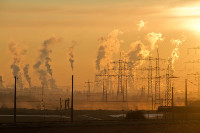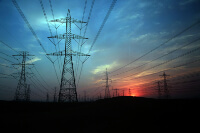
Welcome to Episode 6 of Warming World Explained. I’m Beth Stoeckly, your host. In the preceeding episodes, I have shown how basic physics and chemistry led scientists to predict, starting over a hundred years ago, that burning of fossil fuels would lead to buildup of carbon dioxide in the atmosphere and an increase in the average temperature of the earth. But saying that if we keep doing this, someday there will be a problem is not the same as saying that the increases in extreme weather we are seeing now is the result of human activity. But that is exactly what climate scientists are saying, with 97% of scientists actively working in the field of climate agreeing, that we are seeing changes in the climate which are wholly or largely caused by human activity. Today I would like to talk about some of the evidence driving that consensus.
First, I would like to look at the evidence that the climate is actually changing. For most people today, it is fairly obvious. But there are still some people claiming that, even though we see a lot of extreme weather, it is still within the range of normal variability of the weather. And that is what makes the question difficult: weather is highly variable. From day to day, or considering the same date this year and next year, the temperature can be much hotter or colder, one day can be rainy and the other not, and so on. But averaged over months or years or even decades, the variability is much smaller. The averaged weather is what we call climate. Thus, we can say that Seattle has a wetter climate than Phoenix, although on any given day there could be rain in Phoenix and not in Seattle.
The 1980’s were the warmest decade on record at the time, worldwide. Every decade since has been warmer than the one before it. And there are other observations. Species of animals are moving towards higher latitudes and higher altitudes. Glaciers are receding. Ice sheets in Greenland and Antarctica are melting.
The Northwest Passage, the sea route from the Atlantic to the Pacific through the Artic Ocean to the north of Canada, has been dangerous to impassable because of ice as long as people have been looking for a westward route from Europe to Asia, basically the last 500 years. In the summer of 2007 there was no ice for the first time, and now the passage is navigable every summer. We expect that if the earth is warming, we should be seeing more new record high temperatures than record low temperatures, and this has been observed. We would also expect warm spells to be longer and more intense than previously, and this also has been observed.
The ocean is warming, too. In fact, about 90% of the extra energy goes into the ocean because water has a much greater capacity to store heat than air. The warmer the ocean surface is, the more water evaporates and the increased humidity and increased rainfall this causes have been observed.
Let us consider the evidence that human activity, particularly the burning of fossil fuels, is causing all or most of the warming. Remember in an earlier episode we discussed the fact that before 1950, going back 800,000 years, the proportion of carbon dioxide in the atmosphere was never above 300 ppm. Now it is over 400 ppm and rising and the extra amount is consistent with the amount of carbon dioxide put into the atmosphere from the burning of fossil fuels.
Scientists study the atmosphere from the ground, from weather balloons and airplanes within the atmosphere, and from satellites above it.
First we need some general information about the atmosphere. As you go upwards, the pressure always decreases with altitude because the pressure in each layer has to support the weight of all the air above. The higher you go, the less air is above you, and the lower the pressure in the air at that height.
Temperature is more complicated and can vary for various reasons. In the part of the atmosphere near the ground, temperature usually decreases as you go up. The part of the atmosphere where this is true is called the troposphere, from “tropos” meaning change. This is where the air is usually moving and almost all weather phenomena occur. Various sources give different valued for the height at the top of the troposphere; NASA quotes about 5 miles at the poles and about 9 miles at the equator and in between at mid latitudes.
Above this level, the temperature starts to increase as you go up farther. Since the warmer layers are higher, the air is very stable, and stays in layers of increasing temperature. This part of the atmosphere is called the stratosphere, because it is stratified, or layered, and is not being continually stirred up.
The lack of stirring in the stratosphere means that the carbon dioxide being put into the atmosphere at or near the ground stays in the troposphere.
The extra heat in the stratosphere comes from the absorption of ultraviolet radiation. The energy absorbed from the ultraviolet goes into producing ozone from normal oxygen and breaking ozone molecules, which then form normal oxygen again. This absorption of all but the longest wavelengths of ultraviolet radiation protects life at the surface of the earth and also warms the stratosphere.
We are talking about this here, because if the increase we are seeing in the average temperature at the surface of the earth were caused by, say, increased radiation from the sun, then we would expect to find warming in the stratosphere, too. However, satellite measurements over the last 25 years show that the stratosphere is in fact cooling while the troposphere, the lower atmosphere, is warming. This would make sense if heat from the earth which would otherwise pass through the stratosphere is being trapped by greenhouse gases in the troposphere.
No one has suggested another explanation.
We get more evidence that the carbon dioxide and other greenhouse gases we have put into the atmosphere are causing the heating we observe when we look at the spectrum of infrared light being radiated out into space and the infrared radiation reaching the ground. Remember that electromagnetic waves or radiation come in all wavelengths. And all objects give off electromagnetic radiation, and the spectrum – the distribution of wavelengths and how much at energy is emitted at each wavelength – depends on the temperature. The sun is very hot; most of its radiation is in the visible part of the spectrum. But the visible part of the spectrum is a narrow range that our eyes can see. The sun also gives us longer wavelengths than red – called infrared – and shorter wavelengths than violet – called ultraviolet. These are exactly the same sort of waves as the visible; our eyes are just not sensitive to them. And just as a prism can separate visible light into all the colors of the rainbow – which differ physically by wavelength – we can separate infrared and ultraviolet by wavelength, too. We just have to use instruments because we can’t see the infrared or ultraviolet.
We can also study how carbon dioxide or methane or any other gas interacts with electromagnetic radiation in the laboratory. We find that carbon dioxide, methane, water vapor each has specific bands of wavelengths which it absorbs strongly and some of those bands are in the part of the spectrum where the thermal radiation from the earth is strongest.
Now, when we study the infrared radiation being given off by the earth, and seen by a satellite, we see that the wavelengths that carbon dixide molecules absorb are depleted. That is, there is less radiation at those wavelengths than one would expect from the temperature of the earth and from the strength of radiation at wavelengths that carbon dioxide does not absorb. When ground-based observers look at infrared radiation reaching us from the sky, they see extra radiation at the wavelengths that carbon dioxide absorbs.
What is happening? When a carbon dioxide molecule absorbs energy at one of the wavelengths, it absorbs a specific amount of energy that depends on the wavelength. The molecule will give up the energy and return to its most stable state in one of two ways. It can reradiate the energy itself. Or, if it bumps into another molecule before it radiates the energy, it can give up the extra energy increasing the kinetic energy of the two molecules. This latter will result, after more collisions, in that bit of energy becoming part of the thermal energy of the gas. The gas will be warmer and will give off more thermal radiation.
In either case, we started with radiation coming up from the ground; that is, all of it going upward, on course to leave the earth. After being absorbed, the energy will be radiated in all directions. That means about as much going downward as going upward. So about half of the energy absorbed by the carbon dioxide is prevented from leaving the earth: this is the greenhouse effect. And we see it in the depleted wavelengths of infrared radiation measured by satellites and in the wavelengths with extra radiation seen in infrared spectra of the sky seen from the ground.
The cooling of the stratosphere while the lower atmosphere is warming and the depletion of specific wavelengths of infrared in the radiation leaving earth are both strong evidence that all the carbon dioxide we have put into the atmosphere is causing warming.
You may have heard people say that there is no evidence that carbon dioxide emissions are causing or contributing to global warming. They may be speaking in good faith, repeating what they have heard from other people they trust. But they are misinformed.
You may ask, what fraction of global warming is human-caused. The United Nations Intergovernmental Panel on Climate Change is made up of scientists from around the world and is charged with reviewing and summarizing all available scientific literature on climate. In 2013, in the first part of their Fifth Assessment Report, they said that the best estimates of human induced warming in the period 1951 to 2010 “is similar” to the observed warming. In other words, all or at least the vast majority of observed warming is human-caused.
What I would like you to take away from this episode is this: 97% of scientists working in the field of climate today believe that we are seeing human-caused climate change. That consensus is based on specific scientific results, repeated and confirmed by scientists in various parts of the world, and not dependent on computer modeling.
Until next time, good night for Warming World Explained.



